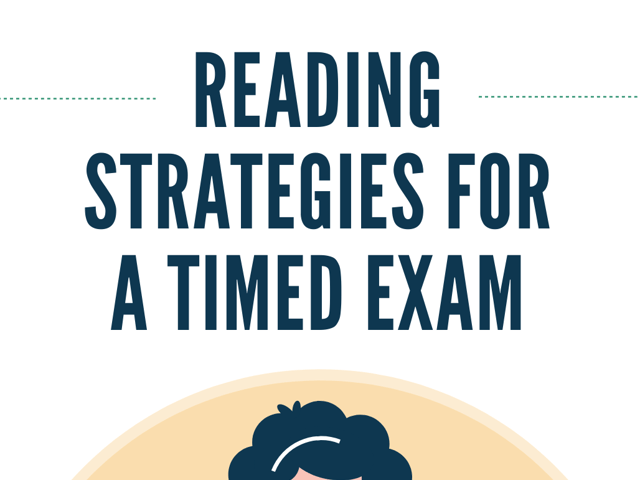
Reading Strategies for a Timed Exam
On your mark, get set…go! Sometimes sitting down to a timed exam can feel like a sprint. You can almost see the seconds tick, tick, ticking away as you rush through the questions in a quest to finish before time is up. And we understand—time is a big stressor! But, believe it or not, sometimes it pays to slow down a little bit and to use your time wisely as opposed to quickly. Here, we share with you some reading strategies to help you through a timed exam with enough time to address all of the questions. Oh, but there’s no time limit on this read, so feel free to take your time and soak it all in.
Look at the Big Picture
Look at the whole test and see how many questions there are, how many passages there are to read, and how long those passages are. Look for formatting hints like bolded text, italics, larger font size, or even pictures and images. When you are reading, those are probably the things to pay closer attention to. Determine how long to spend on each section based on the overall amount of time you have for the test. Then try to keep track of that as you’re working. But don’t worry if some parts take a little longer—better that you take your time and get those answers right than rush through to finish and risk getting more answers wrong.
Know the Rules of the Game
It’s also important to know the rules of the test—some exams dock points for answers that are wrong, but not for answers that are left blank. Sometimes it’s better to answer all of the questions because a wrong answer is better than no answer (maybe it’s only worth a \(\frac{1}{4}\)-point loss to have a wrong answer, but a full-point loss if you leave a question completely unanswered). Know ahead of time the penalty for wrong answers versus the penalty for non-answers.
Read the Directions Carefully
As tempting as it can be to rush through the reading portions on a timed exam, especially the directions, we would encourage you not to do that. What new insight could the directions possibly be giving me, you may ask. Read the passage, answer the questions—easy! But sometimes the directions hold important clues or test-taking strategies themselves. The directions may caution you about the types of questions you are likely to encounter or include important indicator words—tricky ones like “most” or “all” or “except” or “not.” Being aware of these indicator words will help you answer the questions correctly.
The directions may also give insight into how many questions there may be for a particular passage so that you can determine, overall, how much time you should be spending on this section of the test. They may even give you clues about how the text is structured. For example, maybe there is background about the topic provided at the beginning or context about the time period in which an author was writing that will greatly impact how you read the text and interpret the questions.
Know What to Look for and Where to Find It
Sometimes, reading the questions before you read the passage can actually help save you time overall. Knowing what to look for as you read the passage will help you be more alert to finding that information rather than reading a passage, then looking at the questions and trying to remember if you read particular bits of helpful information. You might consider circling key words (if possible) as you read the question, so you know what to look for in the passage.
Know Where to Look for Particular Information
The main idea is likely to be found in the first paragraph and summarized again at the end. Look for the thesis statement in the first paragraph and at the beginning of each body paragraph for the topic sentence. Key transition words like therefore, “however, since, as a result, or for example may help you find specific evidence to help you answer a particular question.
But use the text—go back and refer to it to help you answer the questions. You will never be told you may only read the passage once. If you need to read it again to answer a question, do it.
Address Answer Options Methodically
Try eliminating any answer options you know to be wrong first and then head back into the text to see if you can determine the right answer from the choices you have left. Make an educated guess and then move on—don’t let a particular question eat up too much of your time or get you distracted from the rest of the test.
Don’t Be Afraid to Read All Parts
Though the temptation might be to quickly skim and scan, it is okay to actually read portions of the test. Especially important to read (after the directions) are the test questions and all of the answer options. Sometimes the right answer can be hiding in plain sight and you don’t see it because a key word in another answer option looks right. By reading carefully you might see that you are to look for which answer is not an example of something. You might be told to identify the best answer, which means that there are likely to be multiple answer options that seem right, so consider which best answers the question and try to think like a test-maker.
Don’t Be Afraid to Skip It and Come Back
It can be timesaving to start with the questions that you know and feel confident about and then come back to the ones you need to ponder and consider a little more in-depth.
With paper and pencil test formats, the danger in this is becoming mismatched on your answer document (for instance, you skip #28 to return to it later, but forget to skip it on your answer sheet so you answer #29 in #28’s spot and all of your answers after that are misaligned). Try putting a little mark by skipped questions to avoid this, then erasing these marks when you complete the questions.
In computer test versions, be sure you are allowed to go back to previous questions before you move on from any question. Tests vary in allowing this procedure and you should know the regulations before test day.
There is a possibility that you may run out of time before you have the opportunity to revisit the questions that you skipped. On the plus side, you used your time wisely to answer the questions you felt more confident about (and therefore probably answered correctly) rather than spending too much time on a troublesome question and then feeling “behind” and racing to catch up, making silly mistakes along the way.
Trust Your Gut
Too much thinking can actually cause you to select the wrong answer. Read carefully, then mark the best answer and move on. If you are trying to eliminate incorrect answer options before making your decision, make sure that you look for answers that include wrong or inaccurate information (if any part of an answer option is wrong, the whole thing is wrong) or that include absolutes (all, every, no one, never) as they tend not to be the correct answer because they are so exclusive. Watch out for phrasing like “According to the passage…”, because that means you actually should find evidence of the right answer in the passage and it won’t be based on your past experiences or inferences. Make sure you are answering what is being asked of you.
Yes, timed tests can be nerve-racking and feel like a sprint, but try to consider them more as a marathon. Find your groove, set your pace, and work your way through the questions carefully, but efficiently.

Keep Reading

ACT Blog
Essay Writing Practice and Prompts for the ACT
The ACT writing test is an optional exam, and is not always given as pa…

ACT Blog
How to Do Well on the ACT Essay
Understanding the ACT Essay Before diving into strategies to excel, it…

ACT Blog
How to Study for the ACT in One Week
Getting ready for American College Testing (the ACT) can be a source of…